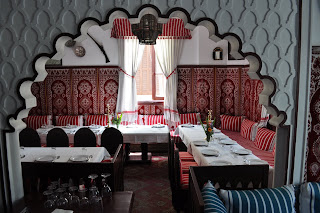The Prado museum is a massive collection of art and sculpture. Many of the paintings in the museum originated from previous royal collections. There are roughly only 1500 of the nearly 7800 paintings on display. This is mainly due to a lack of space within the museum. The Prado is home to masterpieces from such artists as Rubens, Goya, El Greco and Velasquez. Perhaps the most famous painting in the museum is Las Meninas by Velasquez. Unfortunately, the no-camera rule of the Prado prohibited us from making any art of our own. Both main stops on the Madrid tour today (the Prado and the Royal Palace) did not allow photograpy inside.
 The Royal Palace is no longer inhabited by royalty. While the royal family does not live in the palace, they do use it occasionaly for ceremonies of the state. The palace has over 2000 rooms, of which we were only afforded the time to visit around 25. The Prado and Royal Palace are two of the most important sites in a city that would be difficult to visit well in one month, let alone one day. However, these two sites gave us a taste of the splendor that makes up Spain's capital city.
The Royal Palace is no longer inhabited by royalty. While the royal family does not live in the palace, they do use it occasionaly for ceremonies of the state. The palace has over 2000 rooms, of which we were only afforded the time to visit around 25. The Prado and Royal Palace are two of the most important sites in a city that would be difficult to visit well in one month, let alone one day. However, these two sites gave us a taste of the splendor that makes up Spain's capital city.
 After visiting the Prado and the Palace, we were afforded free time in the afternoon until our flamenco dinner. This time was perfect for a return visit to the Prado for a more intense look at its walls, for a visit to the Reina Sofia museum that houses works by such artists as Picasso and Dali, for a visit to the Gran Via and its shopping district, or for catching up on much needed rest at the hotel. Those who chose to explore the city found that certain familiar sites of home would pop up occasionally...such as below.
After visiting the Prado and the Palace, we were afforded free time in the afternoon until our flamenco dinner. This time was perfect for a return visit to the Prado for a more intense look at its walls, for a visit to the Reina Sofia museum that houses works by such artists as Picasso and Dali, for a visit to the Gran Via and its shopping district, or for catching up on much needed rest at the hotel. Those who chose to explore the city found that certain familiar sites of home would pop up occasionally...such as below.
 Those who chose to visit the Reina Sofia museum were treated to works by Picasso and Dali, among others. For some strange reason, this museum would allow photos without flash...and without fear of being tackled by security. One of Pablo Picasso's most famous works, Guernica, was on display.
Those who chose to visit the Reina Sofia museum were treated to works by Picasso and Dali, among others. For some strange reason, this museum would allow photos without flash...and without fear of being tackled by security. One of Pablo Picasso's most famous works, Guernica, was on display. After our free afternoon, we met back at the hotel to head to dinner and a flamenco show. We had the pleasure of enjoying great food, tremendous performances by the dancers and guitarists, and good company during our final evening together in magical Spain. Tomorrow we board our plane to return home.
After our free afternoon, we met back at the hotel to head to dinner and a flamenco show. We had the pleasure of enjoying great food, tremendous performances by the dancers and guitarists, and good company during our final evening together in magical Spain. Tomorrow we board our plane to return home.










 Our first stop was Sevilla's cathedral and Giralda bell tower. This is the third largest church in Europe and the world's largest Gothic church. According to locals, the goal was to build a cathedral so grand that "people who see it will say we are mad." Two of the cathedral's finer features are its tremendous pipe organ of 7,000 pipes and the tomb of Christopher Columbus.
Our first stop was Sevilla's cathedral and Giralda bell tower. This is the third largest church in Europe and the world's largest Gothic church. According to locals, the goal was to build a cathedral so grand that "people who see it will say we are mad." Two of the cathedral's finer features are its tremendous pipe organ of 7,000 pipes and the tomb of Christopher Columbus.
 Following our visit to the cathedral, we made the short walk to the Alcazar, the 10th Century palace built by the Moorish kings and still in use today. The unique architecture of the palace is accentuated by the vastly different styles of the rulers who lived there. As Spanish rule evolved from the Moors to the Christians, so did each addition to this magnificent palace. After leaving the palace, we enjoyed a rest in its lush gardens.
Following our visit to the cathedral, we made the short walk to the Alcazar, the 10th Century palace built by the Moorish kings and still in use today. The unique architecture of the palace is accentuated by the vastly different styles of the rulers who lived there. As Spanish rule evolved from the Moors to the Christians, so did each addition to this magnificent palace. After leaving the palace, we enjoyed a rest in its lush gardens.
 The final stop on our tour of Sevilla was the magnificent Spain Plaza. This plaza was built for the 1929 international fair. Restoration of this panoramic site was recently completed just in time for our visit.
The final stop on our tour of Sevilla was the magnificent Spain Plaza. This plaza was built for the 1929 international fair. Restoration of this panoramic site was recently completed just in time for our visit.
 The white (chalked) facades of Mijas remained beautiful even in the dreary conditions. We proved braver than our absent "donkey taxis" as we traversed the streets of lovely Ronda on our own two (wet) feet! The elevation of the village once provided area farmers with an opportunity for supplementing their agricultural income by offering visitors donkey rides up the mountain side to see the fantastic views provided in the picturesque community which overlooks the ocean. We were accompanied today though by only our knowledgeable local guide (and our umbrellas!)
The white (chalked) facades of Mijas remained beautiful even in the dreary conditions. We proved braver than our absent "donkey taxis" as we traversed the streets of lovely Ronda on our own two (wet) feet! The elevation of the village once provided area farmers with an opportunity for supplementing their agricultural income by offering visitors donkey rides up the mountain side to see the fantastic views provided in the picturesque community which overlooks the ocean. We were accompanied today though by only our knowledgeable local guide (and our umbrellas!) 

 With structures clinging to its sides, it is a dramatic view that can only be fully appreciated in person, but we all took our best shots at capturing it!
With structures clinging to its sides, it is a dramatic view that can only be fully appreciated in person, but we all took our best shots at capturing it!  Tomorrow, we enjoy Seville with it's fabled beauty, and hope the sun comes with us!
Tomorrow, we enjoy Seville with it's fabled beauty, and hope the sun comes with us!






